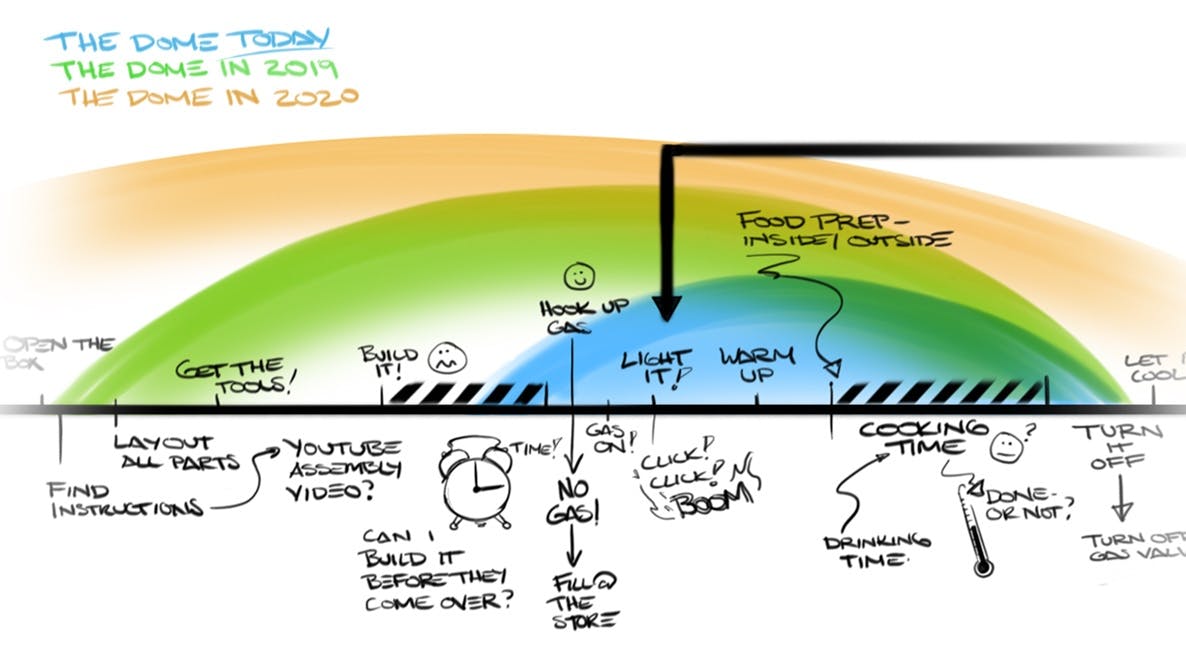I say “Dome of Awesome” and you say…
What's the dome of awesome? It’s that place where your expectations have been met (nay, exceeded!) and you are having a great experience throughout.
I say “Dome of Awesome” and you say…
When I’ve said “dome of awesome” to people, they generally respond with something like, “What is it? I want it. I want to be in the dome of awesome!”
In fact, I mentioned this concept to a client the other day; that we need to expand their dome of awesome and he seemed pretty excited about the idea. It’s a sticky concept, and it can elevate your next ideation session.
What exactly is this dome of awesome? It’s that place where your expectations have been met (nay, exceeded!) and you are having a great experience throughout. It’s a dome because it is a contained “thing” or experience.
I’ve been thinking a lot more about experiences, total experiences, experiences from an individual’s point of view, and not from a product-centric point of view. Yes, the central product use experience must be great, but so does what comes before and after it. Thinking about the whole experience allows us to expand the dome. There is incredible opportunity in those spaces often left unexplored and ignored … a whole lot of awesome to be created and enjoyed. In product development, we tend focus on ‘designing to delight’ only when the user is at that magical moment in time when they are actually using our product.
Setting your dome's dimensions
Why do people shy away from the dome and dome expansion? Chances are, they are measuring the wrong things, but most likely they are operating with an unclear definition of what problem should be solved.
I believe there’s way to measure how far you can and should extend beyond that central focus. It involves a metric– distance, believe it or not – and it starts with a question that can reframe your experience map:
“How far do we need to extend our dome of awesome? How far can we?”
Are you going to have every part of the product experience under the dome, or not? What parts of that experience will you try to bring under the dome over an extended time? How will you strengthen that dome (it’s fragile!) when a competitor tries to shoot holes in it?
I’ll give you an example: a gas grill. The dream of mouth-watering grilled meats and vegetables and entertaining happy guests is what gets customers enticed to buy again and again. But that dream – the central focus of the product experience- is surrounded by unattractive realities: cleaning, storing, fueling…none of them are within the grilling dome of awesome.
Those pain points are obvious, and there’s a high possibility you’re leaving the opportunity to delight on the table. Literally in this case.
So ask: “What’s not so awesome that with a few tweaks could be and we can bring under that dome? Can we squelch a pain point here and there to extend that dome farther outward?”
Draw your dome
Illustrating the dome of awesome with your experience map is first and foremost a way to frame your team’s mindset and give them something to get excited about. But it can also be a planning tool. Combine the distance (extension of the dome) with a timeline (months/years in your product development) and see what you can bring under the dome now, next, and later.
Of course, there’s more to it. You still need to prototype and evaluate to find out what your customers actually consider to be within their own dome of awesome. Not everyone has the same dome in mind. Every facet of the product experience needs to be proven to earn its place under the dome. Which means a lot of work. But imagine the next product development meeting you’re in and someone says ‘Hey, maybe we should keep our dome of awesome focused here for the first few months, and then we expand it over the next year’ That sounds a lot better than the “yes, but…” or just flat-out ”no”.
How do you create a dome of awesome?
- Map out the customer experience with as much detail as possible. Every little step along the way counts. From the time they have the spark of an idea to invest in your product/service to the time they are ready to re-engage.
- Circle the things that you’re doing well. These are the things that you believe fit into what your customers would consider the dome of awesome.
- Now look beyond and see what else should be put under the dome…and by when it needs to be there.
- Keep this up in plain sight. Refer to it and don’t be afraid to call out what’s not under the dome. If we’re uncomfortable with what’s not awesome, we are more likely to fix it!
The point is, experience maps have always been great visualization tools. With the addition of the dome, you can reframe how much of that experience you need/want to focus on while keeping the additional possibilities clearly within sight. It clarifies and simplifies the conversation: it’s under the dome or it’s not. This creates a concrete visual for the team.
So ask yourself – is your product in the dome? Is the experience you are creating in the dome? In not, stand up and shout out, “We must expand the Dome of Awesome!” You are sure to get some attention!
